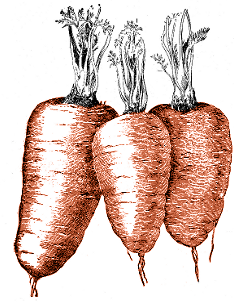Archive for the ‘Garden Diary’ category
Posted in Garden Diary on Thursday, October 21st 2021 (10.13 PM).
This might be the last post on the garden blog for a while; it looks as if it will be going onto a hiatus, for various reasons we don’t need to go into, for an indefinite period. Nevertheless, in the last post I promised to give an update on whether or not the strange chimeric bird food plant—a sunflower surrounded by wheat—would flower. And, indeed, it did. To the delight, as you can see, of bumblebees.
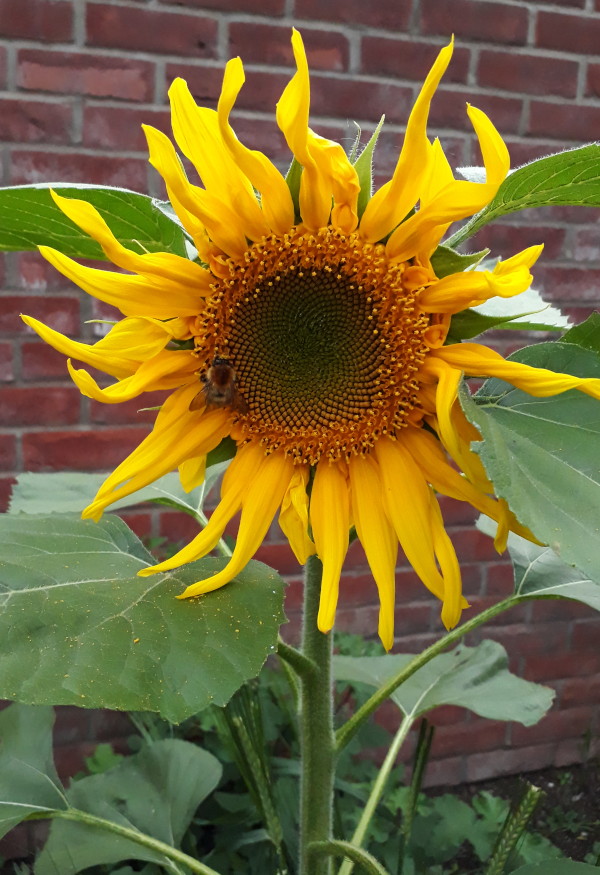
I took this picture about six weeks ago, and it’s been sitting in my to-do pile since. You can see the heads of wheat at the bottom, green still; by now everything has ripened, the wheat has gone yellow and the sunflower has turned into seed for all the local birds. Six weeks ago, as you can see, its yellow was still rich. I’m intrigued by the shape, those tendril-like petals extending like tentacles all the way round. Naturally, I have no idea of finding out what variety it is to try to reproduce it.
sunflower, helianthus, bee, bumblebee
Posted in Garden Diary on Saturday, August 14th 2021 (9.22 PM).
If there were any regular readers of this blog, they would have noticed that since the last post, when the garden was being radically relandscaped, there haven’t been any further updates. Well, the landscaping has finished since then, the garden now has a lawn, an apple tree and a variety of beds which are slowly being populated with plants. So far, of course, the plants all appear to be tiny little things somewhat dwarfed by the amount of empty bare earth between them, but that will slowly change.
This post, though, is something of an aside, before I get around to the Proper Post with a map of the garden and summaries of some of the plants that have been scattered about. Because between a couple of plants which had been properly planted, a strange weed grew up. It started growing and grew up fast; and it seemed to have a strange mixture of leaves, some of them long and thin like a grass and some broad and heart-shaped. In other words almost as if it was a chimera of two completely different types of plant, half-monocotelydon and half-dicotelydon. Outside of science fiction, that’s completely and utterly impossible.
Well, I looked at it more closely today, and I’ve realised what it is. Take a look yourself and see if you can spot it.
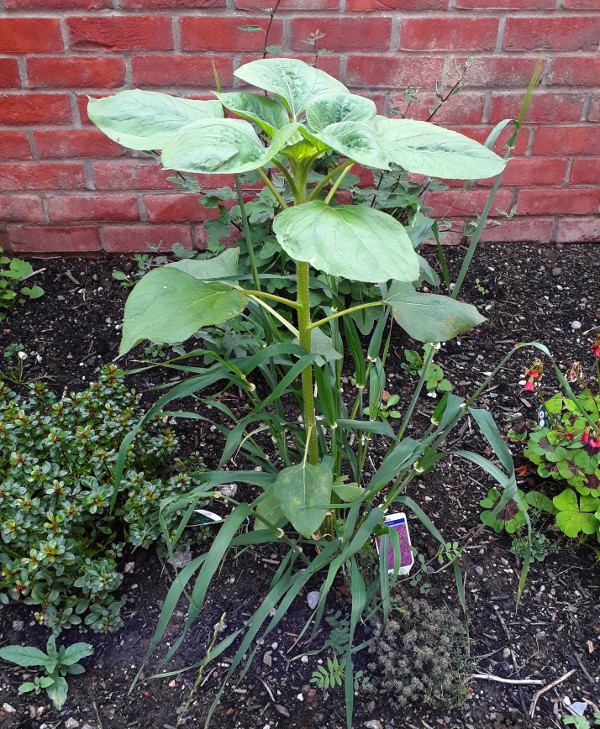
So what sort of plant is it, that I’ve realised I have? It’s a bird food plant, of course!
No, really, look. In the middle, that’s a typical sunflower stem with its flower forming at the centre. Round the outside, some sort of cereal plant, possibly barley. Why on earth would you have a sunflower and a few stems of barley all germinating in exactly the same spot? Because a small lump of bird seed cake was dropped there and has started to grow, of course.
Whether it was accidentally dropped by a passing jackdaw or wood pigeon, or whether it was in the topsoil when it arrived and has germinated now it has light, I don’t know and will never know. The topsoil certainly does have a good number of weed seeds in it, a significant proportion of them nettles, so it possibly was in the soil before it was spread out. The sunflower has probably started a little late in the season for best results, but it will be interesting to see just how high and fast it manages to grow before autumn. If it flowers, I’ll make sure I take a picture.
weeds, weed, sunflower, helianthus
Posted in Garden Diary, The New Garden on Wednesday, April 28th 2021 (5.14 PM).
This blog has been quiet since the end of last year. If you’re a regular reader of the main blog you’ll be aware that in February I left the garden behind and made a new start, with a new-to-me house and garden, in South East Wales. Nothing has changed in the garden of the new house since moving in; there hasn’t been anything to post here, and there’s a good reason for that which I’ll come to in a moment.
I’m writing this today, though, because right now it’s the middle of the 10th UK National Gardening Week. This year’s event, understandably, is themed around wellbeing, about the benefits that gardening can bring to both your physical and mental health. It doesn’t, of course, have to be your own garden; you can get the same benefits from community and public gardens too.
The garden here, on the other hand, is something of a barren empty space at the moment.

On the upside there are plenty of dandelions for the local bees, and a few patches of clover and Herb Robert, even if the rest is a barren stony, sandy desert.
This garden is much bigger than the tiny scrap we had previously, and I’m sensible enough to realise that making over a garden of this size completely from scratch is probably beyond me: even if I thought I could take it on myself, I’d probably not get it finished this decade. However, even if we have had to reach outside for some help with the basics and the layout, there are plans in hand to transform it and create a space that both evokes the same atmosphere as the previous garden did when it had matured, and that we are able to change and evolve over the coming years. I’ll go more into the thoughts behind that further down the path, when change has started to happen.
National Gardening Week, new garden, dandelions, herb robert
Posted in Garden Diary, Photobloggery, The Old Garden In Bristol on Thursday, December 31st 2020 (10.35 AM).
The last day of the year, and the first proper frost to hit the garden. If you read the main blog, you might have already seen yesterday’s post about a frosty cemetery. The garden, though, is rather more sheltered so wasn’t really touched by yesterday’s frost at all. Today was the first day that the frost was hard enough for the cold air to get properly into the garden and touch everything down to the ground.
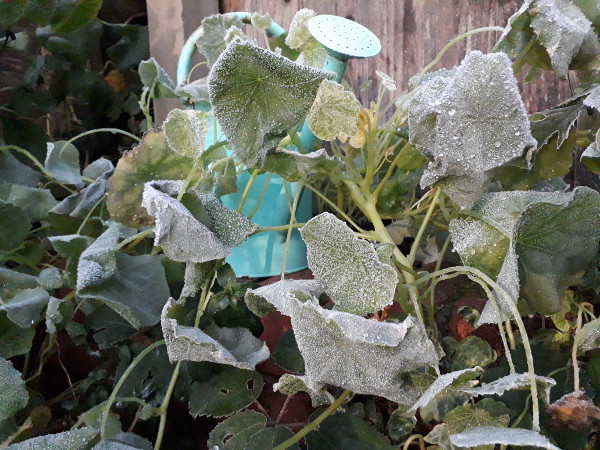
As I’ve said previously the nasturtiums normally have late autumn and early winter mostly to themselves in this garden, and by the time the frost comes the garden often consists mostly of nasturtium. This frost, though, will start to kill them off.

The honeysuckle should be made of somewhat sterner stuff.
The garden has been fairly quiet since I restarted this blog. Hopefully, 2021 will see some interesting new developments. You’ll have to wait and find out exactly what, though.
frost, honeysuckle, Lonicera, nasturtium, Tropaeolum, weather, winter
Posted in Children, Garden Diary, Environmentalism, Experimentation, The Old Garden In Bristol on Wednesday, December 2nd 2020 (5.18 PM).
The previous post was about putting Halloween pumpkins in the garden to decompose. Now they’ve been there for a month, I thought it was about time to post a composite of their gradual decay into the soil.

It makes me a little sad to see this, especially given the goofy grin on The Child Who Likes Animals’ design. Still, I have to remind myself that it is inevitable, and they are just part of the circle of life and death in the garden. They have been broken down by mould, eaten by slugs and snails, and are now feeding the herbs and the honeysuckle.
Halloween, pumpkin, squash, decay, back bed, autumn
Posted in Children, Garden Diary, Environmentalism, Experimentation, The Old Garden In Bristol on Sunday, November 8th 2020 (10.14 AM).
The other day, over on the main blog, I briefly mentioned that the Hallowe’en pumpkins have been put into the darkest corner of the garden, the southern end of the back bed, for the local slugs and snails to eat. As not much grows successfully in that corner of the back bed save for sweet cicely and (once) tree spinach, it tends to be left as something of a wildlife corner; and The Child Who Likes Animals likes to leave things like melon rind there, to see how it attracts invertebrates and to watch it decay. So, a week ago when it was time to put the hollowed-out carved pumpkins in the food waste, we thought it might be a nice idea to leave them in the garden instead.
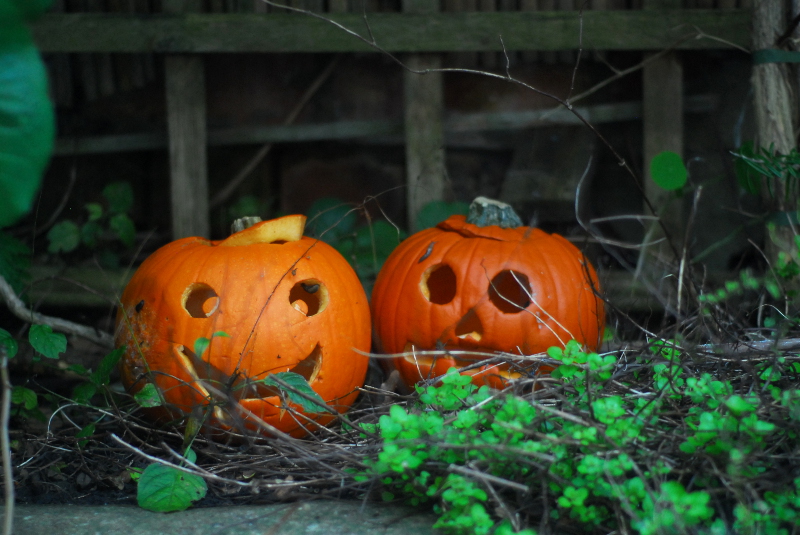
It was getting towards twilight yesterday when I took this photo; but you can see that there are a number of small slugs greatly enjoying them. Mould is spreading, too, and spiders are using them to lurk behind. If they behave like a melon rind does, the flesh will slowly disappear and possibly in a few weeks time only a papery skin will be left.
Halloween, pumpkin, squash, decay, back bed, autumn
Posted in Garden Diary, The Old Garden In Bristol on Sunday, November 1st 2020 (9.47 PM).
A month since the last post on the garden blog, and not much has changed. For a number of reasons I have not done very much at all in the garden, not least the continuous bleak weather: cold, rainy, and blustery. Occasionally there is a clear night and Mars, Saturn and Jupiter sail smoothly across the sky; but more usually the heavens are filled with fast-moving grey scudding clouds.
The plants are still growing, of course; or are settling down for winter. The honeysuckle’s flowers have gone, and it is covered in little dark round berries instead.

The nasturtiums I mentioned previously are still going strong, though, covering the back bed from top to bottom in yellow flowers and straggling halfway across the decking too. The bumblebees are still feeding from them; next year’s queen bumblebees preparing to hibernate, I presume. In this one, however, I spotted an earwig, its head down and pincers outwards.
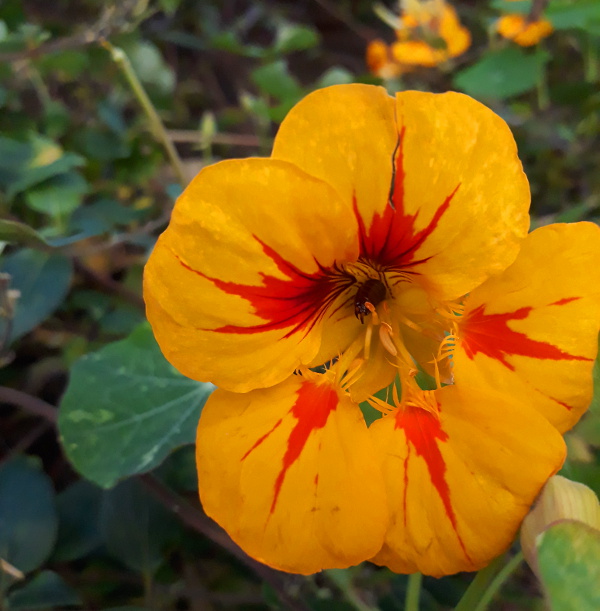
Apparently you can sex earwigs by the size and shape of their pincers. I didn’t try with this one, and left it be inside its flower.
autumn, bumblebee, nasturtium, Tropaeolum, bee, honeysuckle, Lonicera, earwig
Posted in Experimentation, Garden Diary, Practicalities, The Old Garden In Bristol on Friday, May 27th 2016 (10.33 PM).
There haven’t been any posts here in the past month, partly because I was waiting to see if the Zierkürbis seeds would germinate. As they haven’t, I suspect it is safe to say that they were too old to grow successfully.
Not much else has been very successful in the past month, largely because the local slug and snail population has woken up to the fact that there are fresh tender new seedlings all over my garden. So, seedling after seedling has sprung up only to have its baby leaves immediately nipped off. The whole line of pea plants seemed to be doing reasonably well, until over the course of a few days last week something sluglike went eating its way along the row, a couple of plants per night. So far only one is left – ironically, one that The Child Who Likes Fairies grew by accident in the bucket of stale compost she has been given to “play digging” in.
So now, a whole new round of seed-sowing has started, this time with the idea that everything will be germinated indoors, and kept indoors overnight until it is chunky enough to survive a brief slug attack. The next round of peas will be going into containers, on the grounds that previously, when growing peas in containers, they stayed remarkably slug-free. We’ve switched pea varieties too, because the peas we were using previously had less than a 50% success rate at germinating: not great if you want to try to get back on track quickly and only have limited space to do it in.
pea, slug, snail, zierkürbis
Posted in Decorative, Experimentation, Garden Diary, Inspiration, The Old Garden In Bristol on Tuesday, April 26th 2016 (9.46 PM).
A few years ago, now, we spent a couple of weeks one September on a camping trip to the Mittelrhein region of Germany. We spent those weeks driving around various towns and cities: Koblenz, Köln, Mainz, Bonn, countless smaller towns with a town wall, four gates, gingerbread architecture and a castle overlooking it all. Towards the south of the area we visited every valley was covered in vineyards; but further north, where the land flattened out towards the spires of Köln cathedral, we drove along surrounded by pumpkins and squashes ready for harvest.
Up in the Eifel hills, west of Koblenz and Andernach, we visited the Benedictine abbey of Maria Laach, tucked away inside the crater of a beautiful, placid, dormant volcano. In the abbey’s shop we bought two souvenirs: a bottle of the roughest cider I’ve ever tasted outside Somerset, and a packet of ornamental squash seeds, a variety of Curcubita pepo called “Schwanenhals”, or “Swan-neck”. In our tent we drank the cider and grimaced; and when we got home, the packets of seeds went into the seed tin. No doubt to German gardeners they are just a regular brand of seeds from the local garden centre, but to us they were something of a holiday souvenir.
We never actually planted them, though, but the other week when working out what we could grow within our new set of gardening tenets, and as I was going through my seed tin working out what might be salvageable and workable within those guidelines, I came across the Zierkürbis packet. The seeds are obviously well past their recommended sowing date, but the longer they were left on the shelf the less viable they would always be in any case. So today, all 9 seeds in the packet went into fibre pots on the windowsill; the hope being that, should any sprout, they will be large enough to be transferred outside right at the ideal time of year.

It will, of course, be slightly disappointing if nothing comes up; but better than never knowing at all.
squash, zierkürbis
Posted in Experimentation, Garden Diary, The Old Garden In Bristol on Thursday, April 21st 2016 (9.52 PM).
Seven of the pea seedlings that we all sowed together a fortnight or so ago were looking healthy, upright, and if anything a bit constricted; so this afternoon with the childrens’ help I planted them out in the back bed. Now, I’m just paranoid that slugs are going to descend on them en masse overnight and chomp them off at the ground. I’ve already been outside twice tonight with a lantern to try to detect the oncoming horde, but haven’t spotted any at all so far.
The seed peas had been sown in “expensive” fibre pots from the garden centre. However, I’m not sure they worked as well as they could have: unlike when I have done that in previous years, the pots seemed to stay very solid and the seedlings found it hard to push roots through their walls. So, the next batch of seed peas have been sown in cheap fibre pots from the pound shop. I’m not sure that “under 50%” was the greatest germination success rate, so hopefully the next batch will be better.
germination, pea


